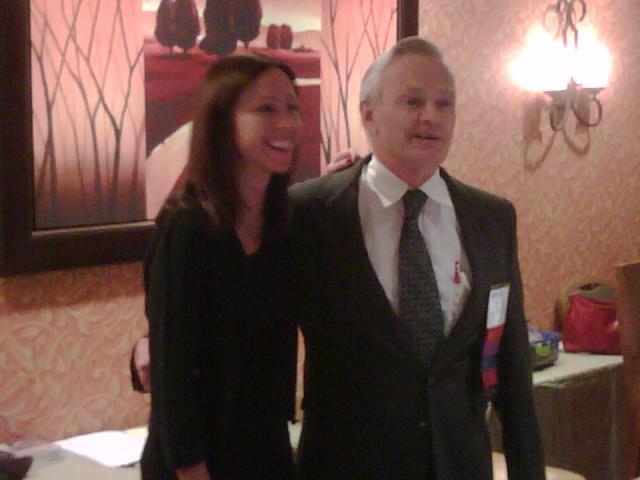Why 8 random things? Because that’s the number of random things I’ve got listed below, that’s why – do I look like Letterman?
OK, so I spent this week closing some business in California, and also 3 days at the very well-attended and immaculately-organized IWLPC show, which is starting to mutate into the WLP and MEMS show, in the same way that Semicon West budded into the Semicon West plus Solar Wild-West show in 2008 and 2009. I will say a big thank you to Lee Smith of Amkor and Dan Baldwin of Engent for their excellent and worthwhile training programs - they have a lot to teach us. Here’s some other stuff I learned:
1. From Dr Rao Tummala’s Keynote Speech: Moore’s Law may be leading the smaller and smaller revolution, and Packaging is severly lagging behind (no surprise to anyone who’s been watching the ITRS for the last five years), but the real surprise is how the overall system that the silicon chip and the package are housed in is similarly dragging its feet. See 7. (below) for some insight into the "why" here.
2. If you are chairing a session, you really will need a good 30minutes start on the session, to ensure everything is in apple pie order. Corollary: Just because the projector is working, doesn’t mean it is connected to your laptop, and my apologies to Dr Raj Gupta of Volant Technologies for slowing him down. He did take the slight delay to starting his presentation in his stride, however, which shows what a gentleman he is!
3. WL-CSP for high-end, fine pitch processors with ULK dielectric layers may never get off the ground, and the competition is cheap, inorganic interposer technologies that have CTE’s close to silicon. Getting low pitch, high I/O conductive holes in glass, however, is no picnic. And would all those muttering about “Flip-Chip on CBGA?!” please keep their comments to themselves: what’s old is new again.
4. If you ask the same question of experts from 3 different marketing research companies, you will get three radically different answers, each within a certain range of “correct” depending on how they view the market. A summary of all of the answers will be very helpful in determining a course of action, and you will learn a lot about the extent to which each organization is blind-sided in their market view.
5. The phrases “killer app” and “smaller, cheaper, faster” have died the death. Yay! I don’t mourn the latter, but I really didn’t get a good feel for what actual DEVICE market need is driving WLP and 3D integration. Yes: Toshiba camera modules in 2007. 8 stack DRAM modules in 2008…but the sensor / logic / RF / NAND / DRAM / MEMS / bacon / lettuce / tomato stack up envisioned for 2013 may be way off base: beaten back by simple throughput, KGD and heat-dissipation issues.
Corollary: Speed of technology change is fine in and of itself, but what concerns me is the VELOCITY of change. As you’ll recall, velocity is a vector quantity, necessitating that you state the direction of motion. Going fast down a dark alley is never a good idea. Speaking of which...
6. DARPA does the freakiest things! Dr Alan Rae (one of the presenters at the Plenary MEMS session I chaired) shared one of the ways the US government is planning on spending our tax dollars. Radio-controlled flies. No Halloween joke. The basis of this project proposal is to put a chip into an insect (e.g. your regular Musca Domestica: the common house fly), and use the energy (motion/heat/electrochemical) generated by a baby fly… OK, a maggot (thank you, John Fowles)… to power the device, which will have nanowires embedded in the insect’s nervous system. These microwires will interface with the fly’s nerves as they grow, allowing you robotic control over the fly, so it goes wherever you want it to.
Over a glass of wine, Alan and I saw some issues here: most particularly as said fly will also have some degree of freewill. One can envision the vexed fly oscillating in some metastable state: torn between the radio-control chip telling it to continue spying on a terrorist cell, and its innate instincts telling it to commence chowing down in the terrorists’ outhouse. “HELP MEEEE!”
7. There is no attempt made yet to shrink the human finger or the human eyeball, so input and output devices will remain severe limitations. Witness a recent text message to my boss on “Fkuxes” this week. Ross Berntson responds immediately “Fkuxes is a new product line for us ;)…” Yeah, LOL! But you see the problem: Blackberry keys and human thumbs…
After chatting to my favorite futurist, Dr Ken Gilleo (pictured right with Leslee Johns) this week, I think we’re safe in assuming that, based on all the above, the next step by 2020 will be DIS. Device in Skull. Bluetooth for the central nervous system: it will look like telepathy. Nanowires will communicate with visual, vocal and aural nerves, and the whole thing could be placed in a sinus or some other pretty vacant bio-real-estate. You can use a microturbine to harvest the energy from breathing. Again, shunting (not merely tapping into, but SHUNTING) and switching the nerves from DIS to brain will present problems, but I’m sure we will see some biotech answers to this – binuclear Schwann cells or some such. An idea not to be sneezed at. Not that sneezing would be a good idea anyway, come to think of it. Which reminds me....
8. Extremely important: Do not make a funny comment to Alan Rae when he just took a bite of dessert. Particularly during the keynote speech. Sorry, Alan. Was funny, though, right?
Cheers! Andy


